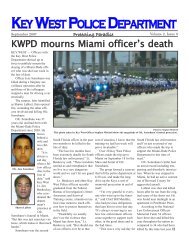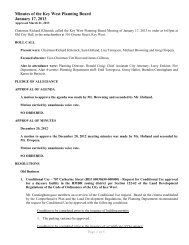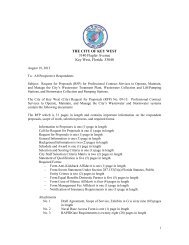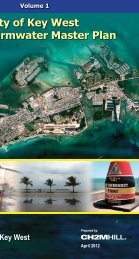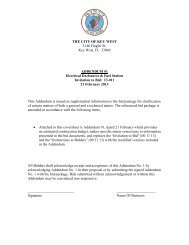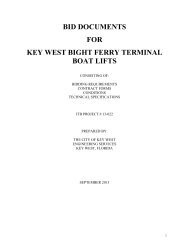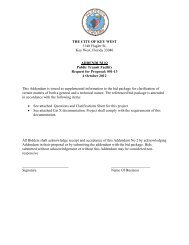Atkins North America, Inc. - KeyWestCity.com
Atkins North America, Inc. - KeyWestCity.com
Atkins North America, Inc. - KeyWestCity.com
Create successful ePaper yourself
Turn your PDF publications into a flip-book with our unique Google optimized e-Paper software.
Resumes<br />
Project Team Resumes | 2-40<br />
Registrations/Licenses<br />
Professional Surveyor and<br />
Mapper (PSM):<br />
Florida, 4431, 1988<br />
Professional Land Surveyor<br />
(PLS):<br />
Virgin Islands, 325573, 2004<br />
Professional Affiliations<br />
Florida Surveying and<br />
Mapping Society (FSMS)<br />
Roberto D. Mantecon, PLS, PSM<br />
Surveying<br />
Mr. Mantecon has 33 years of extensive experience in conducting and managing boundary,<br />
geographic information systems (GIS), construction layout, geodetic control, hydrographic,<br />
right-of-way, route, sectional, cadastral, and topographic surveys for environmental (including<br />
stormwater, mitigation, and sewer utilities), and transportation. He also has in-depth knowledge<br />
of <strong>com</strong>puter-aided design (CAD) and global positioning systems (GPS) surveys. He has<br />
strong technical and <strong>com</strong>munication skills, with the ability to resolve <strong>com</strong>plex problems and<br />
convey solutions through multiple teams.<br />
During his career—all with <strong>Atkins</strong>—Mr. Mantecon has served as the survey manager or<br />
surveyor in charge for many stormwater-related projects, including the following:<br />
Florida Department of Environmental Protection (FDEP) Beach Management Program<br />
General Engineering Consulting Services, Florida (Statewide) (FDEP). This project for<br />
FDEP, Bureau of Beaches and Coastal Systems, consisted of developing and implementing<br />
a long-term strategic beach management plan (SBMP) to restore critically eroding beaches.<br />
Components of the plan included the identification of regional beach management issues such<br />
as erosion, poor public access, navigation problems, and environmental issues, and the development<br />
of long-term solutions. The plan also provided an innovative approach for integrating data<br />
from different sources (e.g., digital aerial photography, conventional survey data, and laser/light<br />
detection and ranging [LIDAR] mapping) using GIS.<br />
Florida Department of Transportation (FDOT) District Six Districtwide Additional<br />
Highway System Right-of-Way Maps, District Six (FDOT District Six). As project manager<br />
and senior surveyor, he led, what initially began as a five-year miscellaneous survey services<br />
contract, for 15 years. He has <strong>com</strong>pleted hundreds of miles of route surveys, along with associated<br />
geodetic control, data collection, boundary surveys, topographic surveys, corridor maps,<br />
hydrographic surveys, and parcel mapping throughout the district including the Florida Keys;<br />
and has served as an extension of District Six staff as a trusted advisor in <strong>com</strong>plex technical<br />
matters. In addition, as part of the new reselection process, he took on the task of updating<br />
the District’s vertical control network to the <strong>North</strong> <strong>America</strong>n Vertical Datum of 1988 (NAVD88),<br />
and has recently <strong>com</strong>pleted GIS databases for Monroe and Miami-Dade Counties to assist the<br />
District’s survey staff in maintaining their project control information.<br />
High-Water Marks Location for Hurricane Katrina, Mississippi and Alabama. As survey<br />
team leader, he was responsible for managing field and office efforts to map high-water marks<br />
established during Hurricane Katrina over the coast of Mississippi and Alabama using advanced<br />
GPS techniques and conventional survey methods. <strong>Atkins</strong> was tasked by URS to survey the<br />
flagged high-water marks as a result of the coastal flooding of Hurricane Katrina. The project<br />
limits stretched from the Florida Panhandle to the western boundary of the Mississippi coast.<br />
This data was to be used to accurately document the flooding and help the Federal Emergency<br />
Management Agency (FEMA) update flood maps and prepare for future disasters. The highwater<br />
marks were determined by using evidence of mud lines, water stains, debris, wrack lines,<br />
and eyewitness testimony. In addition, the high-water marks were surveyed over a two-month<br />
period using seven survey crews. The survey crews used static GPS methods and conventional<br />
leveling to determine the horizontal coordinates (latitude and longitude) and elevation for each<br />
high-water mark. Each point was collected horizontally in the <strong>North</strong> <strong>America</strong>n Datum of 1983<br />
(NAD83), and vertically in NAVD88. The high-water marks were surveyed to the accuracy of<br />
0.25 feet vertically and 10 feet horizontally with a 95% accuracy level of the result. Points that<br />
could not be collected directly with GPS were surveyed by using conventional leveling techniques<br />
from a static GPS reference point.<br />
0006.021798.0611<br />
<strong>Atkins</strong> | RFQ No. 11-004 Truman Waterfront Upland Design



